Hospital-Based Surveillance to Estimate the Burden of Rotavirus Gastroenteritis in Children Below Five Years of Age in Romania
Abstract
Introduction
Methods
Study design and population
Sample size calculation
Ethical considerations
Laboratory methods
Statistical analyses
Results
Population characteristics
Occurrence of RVGE
Age distribution of RVGE
Seasonality of RVGE
Genotype distribution
Clinical characteristics of RVGE disease
Discussion
Conclusion
Author Contributions
Trial registration:
Acknowledgments
Trademark:
Conflicts of Interest
Role of the funding source:
References
- Parashar, U.D.; Bresee, J.S.; Gentsch, J.R.; Glass, R.I. Rotavirus. Emerg Infect Dis. 1998, 4, 561–570. [Google Scholar] [CrossRef]
- Parashar, U.D.; Gibson, C.J.; Bresse, J.S.; Glass, R.I. Rotavirus and severe childhood diarrhea. Emerg Infect Dis. 2006, 12, 304–306. [Google Scholar] [CrossRef]
- Soriano-Gabarró, M.; Mrukowicz, J.; Vesikari, T.; Verstraeten, T. Burden of rotavirus disease in European Union countries. Pediatr Infect Dis J. 2006, 25 (Suppl. S1), S7–S11. [Google Scholar] [CrossRef]
- Forster, J.; Guarino, A.; Parez, N.; et al. Hospital-based surveillance to estimate the burden of rotavirus gastroenteritis among European children younger than 5 years of age. Pediatrics. 2009, 123, e393–e400. [Google Scholar] [CrossRef]
- Giaquinto, C.; Van Damme, P.; Huet, F.; et al. Clinical consequences of rotavirus acute gastroenteritis in Europe, 2004-2005: The REVEAL study. J Infect Dis. 2007, 195 (Suppl. S1), S26–S35. [Google Scholar] [CrossRef]
- Ogilvie, I.; Khoury, H.; Goetghebeur, M.M.; El Khoury, A.C.; Giaquinto, C. Burden of community-acquired and nosocomial rotavirus gastroenteritis in the pediatric population of Western Europe: A scoping review. BMC Infect Dis. 2012, 12, 62. [Google Scholar] [CrossRef]
- Gleizes, O.; Desselberger, U.; Tatochenko, V.; et al. Nosocomial rotavirus infection in European countries; a review of the epidemiology, severity and economic burden of hospital-acquired rotavirus disease. Pediatr Infect Dis J. 2006, 25 (Suppl. S1), S12–S21. [Google Scholar] [CrossRef]
- Ogilvie, I.; Khoury, H.; El Khoury, A.C.; Goetghebeur, M.M. Burden of rotavirus gastroenteritis in the pediatric population in Central and Eastern Europe: Serotype distribution and burden of illness. Hum Vaccin. 2011, 7, 523–533. [Google Scholar] [CrossRef] [PubMed]
- Meszner, Z.; Balogh, A.; Banyai, K.; et al. The clinical burden of rotavirus disease: Retrospective analysis of infant and childhood gastroenteritis in seven countries in central and eastern Europe. Pediatr Infect Dis J. 2008, 27, S33–S41. [Google Scholar] [CrossRef]
- Serban, D.; Jebeleanu, L.; Andronescu, D.; et al. The annual and seasonal variation in the bacteria and rotaviruses implicated in the etiology of diarrheal diseases in children. Bacteriol Virusol Parazitol Epidemiol. 1992, 37, 58–66. [Google Scholar] [PubMed]
- Ulmeanu, C.; Nistor, I.; Crăciun, M.D.; Ion-Nedelcu, N. Frequency and severity of rotavirus acute gastroenteritis hospitalized in Bucharest, Romania. Results of a case-control study. Bacteriol Virusol Parazitol Epidemiol. 2009, 54, 41–46. [Google Scholar]
- Strat, E.; Tansanu, I.; Goția, S.; et al. Detection of group rotavirus antigen with Romanian ELISA kits in the acute gastroenteritis of the infant and young child. Rev Med Chir Soc Med Nat Iasi. 1986, 90, 323–325. [Google Scholar]
- Avram, G.; Zavate, O.; Combiescu, A.A.; et al. Detection of the rotavirus group antigen by a screening test using the ELISA-IC kit in subjects with acute gastroenteritis, at the pediatric services of Moldavia. Virologie 1987, 38, 169–175. [Google Scholar] [PubMed]
- Mihalache, D.; Fîntînaru, R.; Iacob, M.; Simonca, C. Clinical study of acute diarrhea caused by rotavirus. Rev Med Chir Soc Med Nat Iasi. 2005, 109, 488–491. [Google Scholar] [PubMed]
- Lesanu, G.; Becheanu, C.A.; Vlad, R.M.; Pacurar, D.; Tincu, I.F.; Smadeanu, R.E. Clinical characteristics of rotavirus diarrhea in hospitalized Romanian infants. Pediatr Infect Dis J. 2013, 32, 89–91. [Google Scholar] [CrossRef]
- Ruiz-Palacios, G.M.; Pérez-Schael, I.; Velázquez, F.R.; et al. Safety and efficacy of an attenuated vaccine against severe rotavirus gastroenteritis. N Engl J Med. 2006, 354, 11–22. [Google Scholar] [CrossRef]
- Linhares, A.C.; Velázquez, F.R.; Pérez-Schael, I.; et al. Efficacy and safety of an oral live attenuated human rotavirus vaccine against rotavirus gastroenteritis during the first 2 years of life in Latin American infants: A randomised, double-blind, placebo-controlled phase III study. Lancet. 2008, 371, 1181–1189. [Google Scholar] [CrossRef] [PubMed]
- Vesikari, T.; Matson, D.O.; Dennehy, P.; et al. Safety and efficacy of a pentavalent human-bovine (WC3) reassortant rotavirus vaccine. N Engl J Med. 2006, 354, 23–33. [Google Scholar] [CrossRef]
- Vesikari, T.; Karvonen, A.; Prymula, R.; et al. Efficacy of human rotavirus vaccine against rotavirus gastroenteritis during the first 2 years of life in European infants: Randomised, double-blind controlled study. Lancet. 2007, 370, 1757–1763. [Google Scholar] [CrossRef] [PubMed]
- World Health Organization. Meeting of the Strategic Advisory Group of Experts on immunization, October 2009—Conclusions and recommendations. Wkly Epidemiol Rec. 2009, 84, 517–532. [Google Scholar]
- Bresee, J.; Parashar, U.; Holman, R.; et al. Generic Protocol for Hospital-Based Surveillance to Estimate the Burden of Rotavirus Gastroenteritis in Children Under 5 Years of Age. Field Test Version. 2002. Available online: http://whqlibdoc.who.int/hq/2002/WHO_V&B_02.15.pdf (accessed on 24 September 2013).
- Ruuska, T.; Vesikari, T. Rotavirus disease in Finnish children: Use of numerical scores for clinical severity of diarrhoeal episodes. Scand J Infect Dis. 1990, 22, 259–267. [Google Scholar] [CrossRef]
- Frühwirth, M.; Heininger, U.; Ehlken, B.; et al. International variation in disease burden of rotavirus gastroenteritis in children with community- and nosocomially acquired infection. Pediatr Infect Dis J. 2001, 20, 784–791. [Google Scholar] [CrossRef]
- Coris BioConcept.RotaStrip™. Rapid Diagnostic Test for in Vitro Detection of Rotavirus in Stool Specimens. 2012. Available online: http://www.corisbio.com/Products/Human-Field/Rota.php (accessed on 24 September 2013).
- Iturriza-Gómara, M.; Kang, G.; Gray, J. Rotavirus genotyping: Keeping up with an evolving population of human rotaviruses. J Clin Virol. 2004, 31, 259–265. [Google Scholar]
- Gentsch, J.R.; Glass, R.I.; Woods, P.; et al. Identification of group A rotavirus gene 4 types by polymerase chain reaction. J Clin Microbiol. 1992, 30, 1365–1373. [Google Scholar] [CrossRef]
- van Doorn, L.J.; Kleter, B.; Hoefnagel, E.; et al. Detection and genotyping of human rotavirus VP4 and VP7 genes by reverse transcriptase PCR and reverse hybridization. J Clin Microbiol. 2009, 47, 2704–2712. [Google Scholar] [CrossRef] [PubMed]
- Giaquinto, C.; van Damme, P. REVEAL Study Group. Age distribution of pediatric rotavirus gastroenteritis cases in Europe: The REVEAL study. Scand J Infect Dis. 2010, 42, 142–147. [Google Scholar] [CrossRef] [PubMed]
- Diez-Domingo, J.; Baldo, J.M.; Patrzalek, M.; et al. Primary care-based surveillance to estimate the burden of rotavirus gastroenteritis among children aged less than 5 years in six European countries. Eur J Pediatr. 2011, 170, 213–222. [Google Scholar] [CrossRef]
- Williams, C.J.; Lobanov, A.; Pebody, R.G. Estimated mortality and hospital admission due to rotavirus infection in the WHO European region. Epidemiol Infect. 2009, 137, 607–616. [Google Scholar] [CrossRef]
- O’Ryan, M. The ever-changing landscape of rotavirus serotypes. Pediatr Infect Dis J. 2009, 28 (Suppl. S3), S60–S62. [Google Scholar] [CrossRef]
- Van Damme, P.; Giaquinto, C.; Maxwell, M.; Todd, P.; Van der Wielen, M. REVEAL Study Group. Distribution of rotavirus genotypes in Europe, 2004-2005: The REVEAL Study. J Infect Dis. 2007, 195 (Suppl. S1), S17–S25. [Google Scholar] [CrossRef] [PubMed]
- Antunes, H.; Afonso, A.; Iturriza, M.; et al. G2P[4] the most prevalent rotavirus genotype in 2007 winter season in a European non-vaccinated population. J Clin Virol. 2009, 45, 76–78. [Google Scholar] [CrossRef]
- D’Souza, R.M.; Hall, G.; Becker, N.G. Climatic factors associated with hospitalization for rotavirus diarrhoea in children under 5 years of age. Epidemiol Infect. 2008, 136, 56–64. [Google Scholar] [CrossRef] [PubMed]
- Centers for Disease Control and Prevention (CDC). Reduction in rotavirus after vaccine introduction—United States, 2000-2009. MMWR Morb Mortal Wkly Rep. 2009, 58, 1146–1149. [Google Scholar]
- Paulke-Korinek, M.; Rendi-Wagner, P.; Kundi, M.; Kronik, R.; Kollaritsch, H. Universal mass vaccination against rotavirus gastroenteritis: Impact on hospitalization rates in austrian children. Pediatr Infect Dis J. 2010, 29, 319–323. [Google Scholar] [CrossRef] [PubMed]
- Lambert, S.B.; Faux, C.E.; Hall, L.; et al. Early evidence for direct and indirect effects of the infant rotavirus vaccine program in Queensland. Med J Aust. 2009, 191, 157–160. [Google Scholar] [CrossRef]
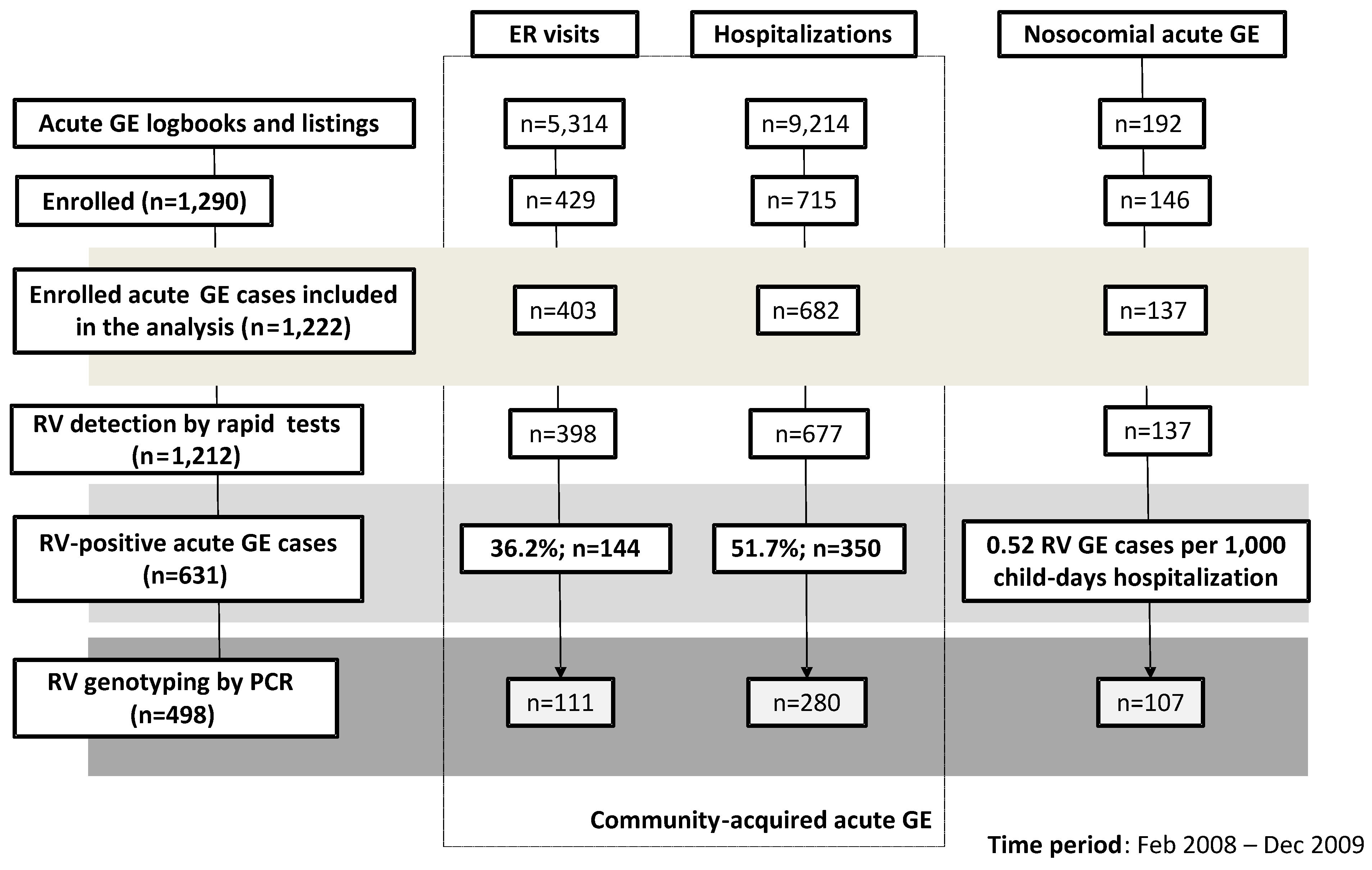
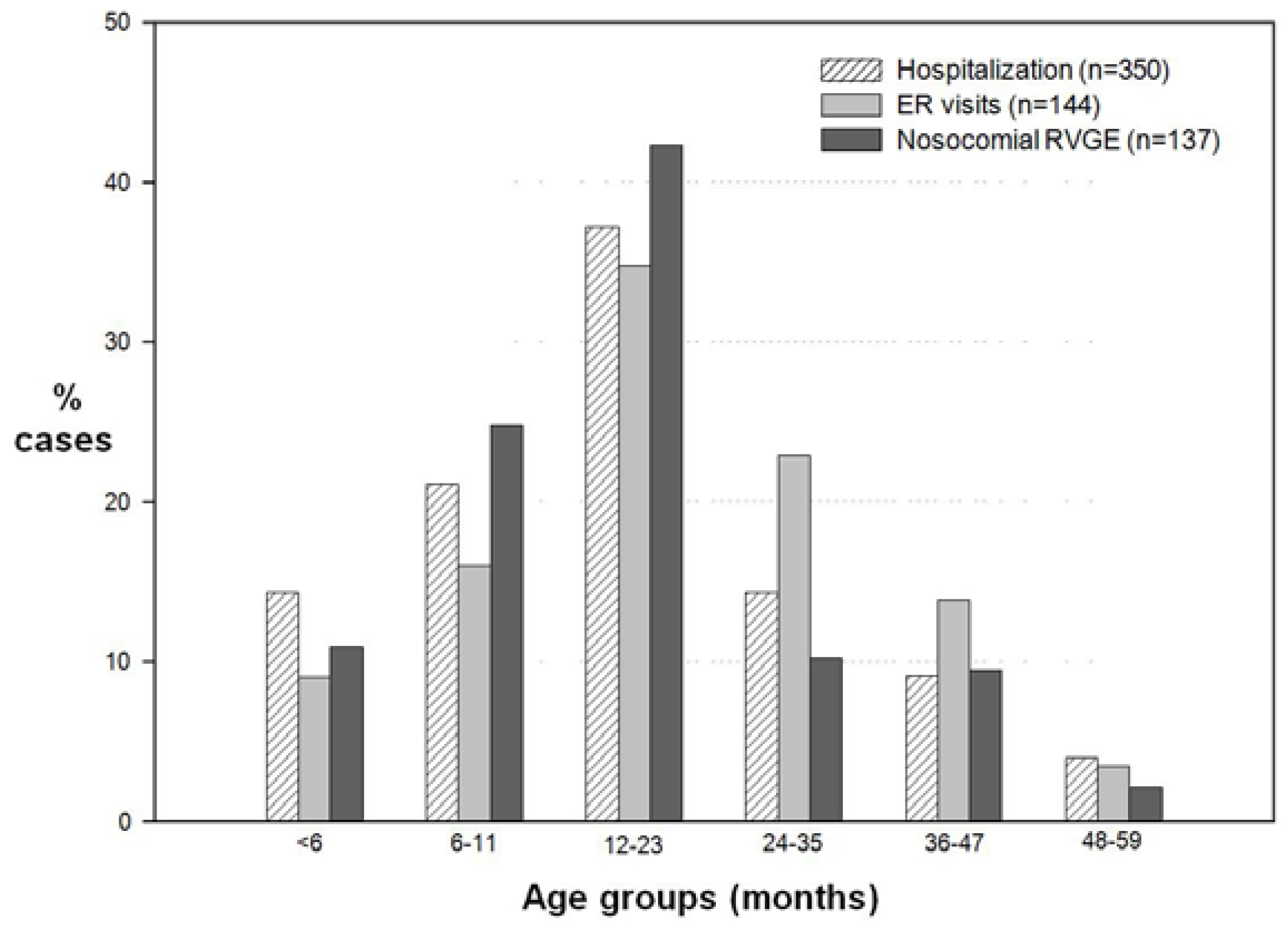
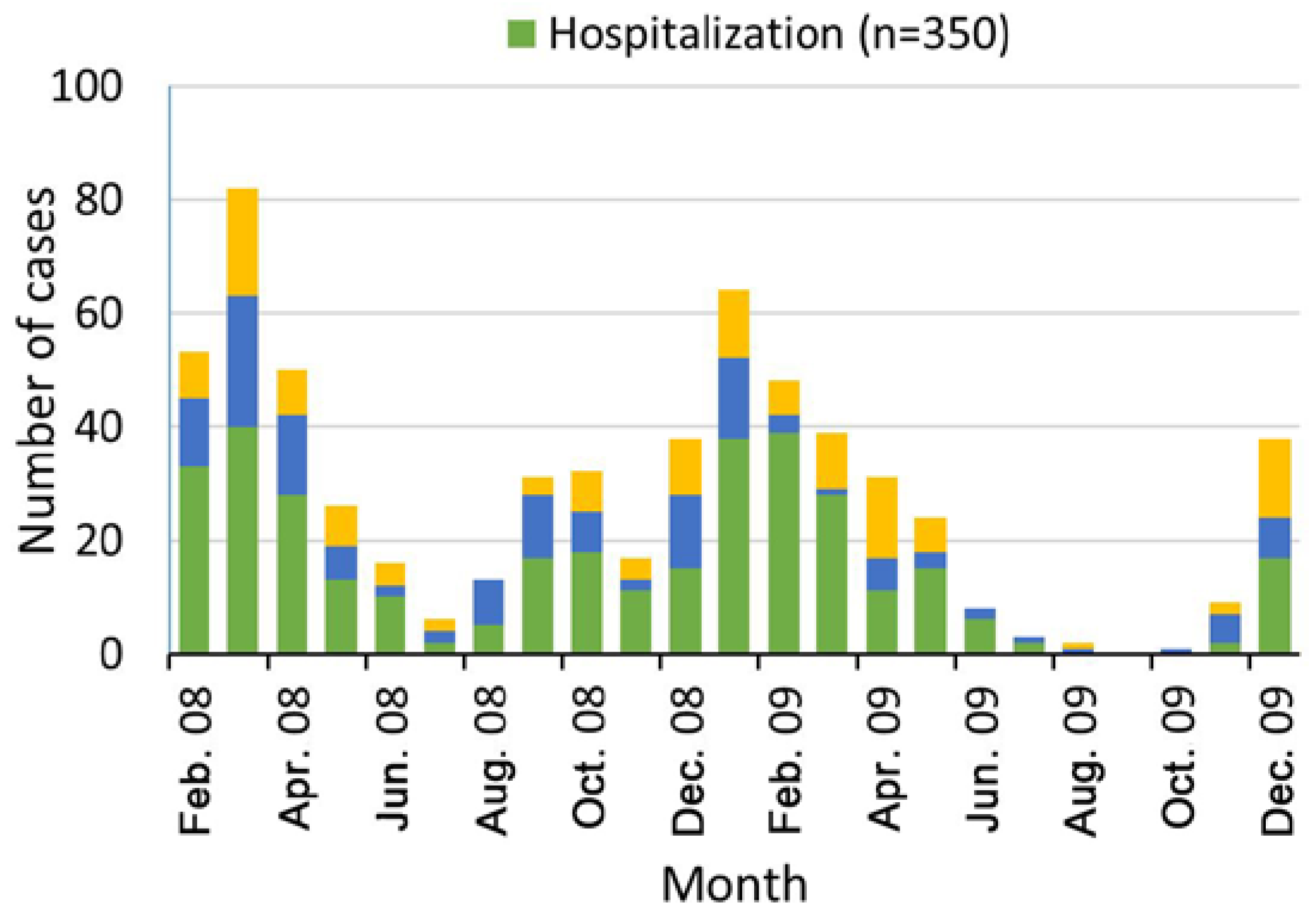
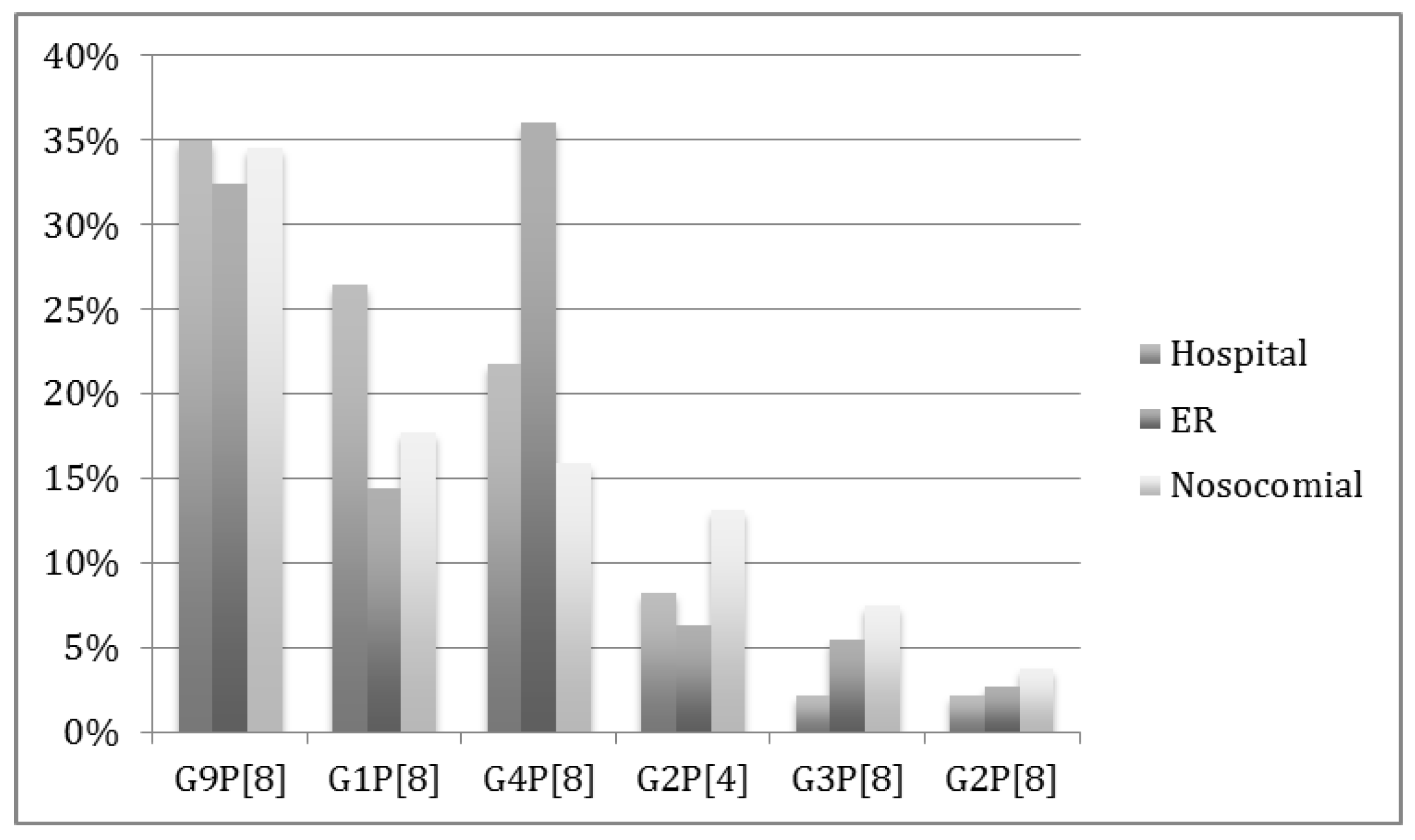
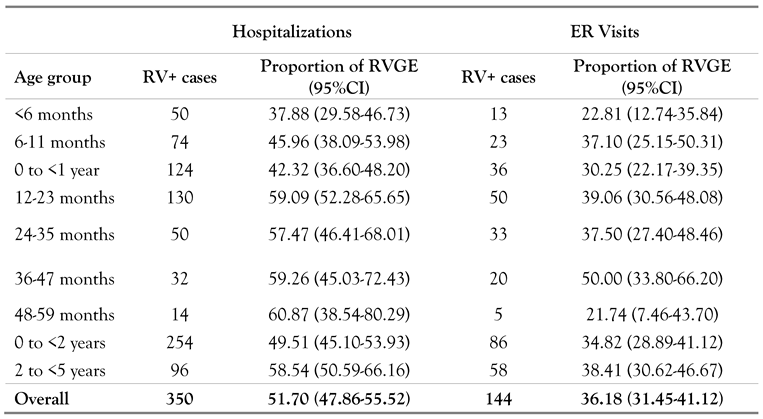
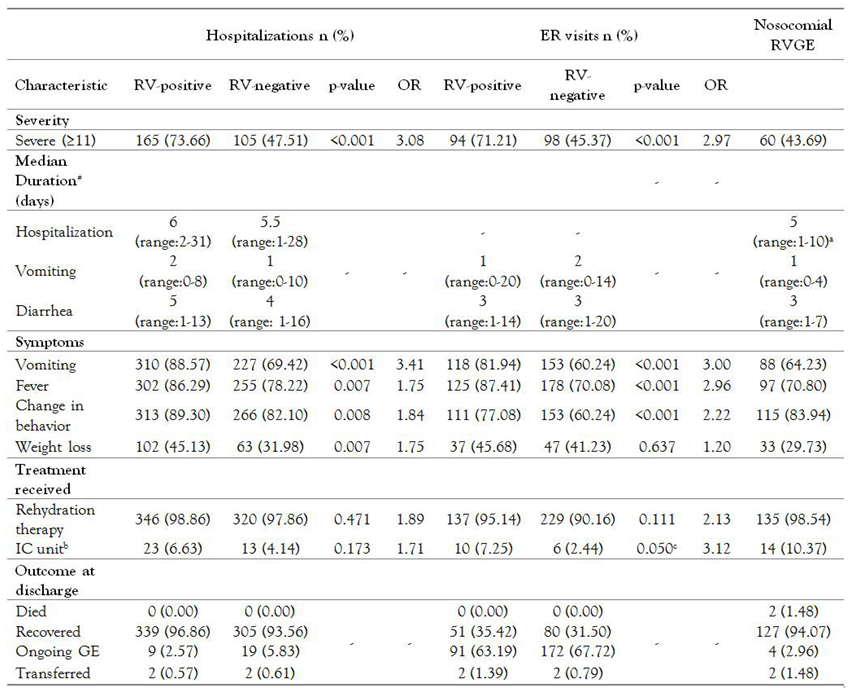
© GERMS 2014.
Share and Cite
Anca, I.A.; Furtunescu, F.L.; Pleșca, D.; Streinu-Cercel, A.; Rugină, S.; Holl, K. Hospital-Based Surveillance to Estimate the Burden of Rotavirus Gastroenteritis in Children Below Five Years of Age in Romania. GERMS 2014, 4, 30-40. https://doi.org/10.11599/germs.2014.1053
Anca IA, Furtunescu FL, Pleșca D, Streinu-Cercel A, Rugină S, Holl K. Hospital-Based Surveillance to Estimate the Burden of Rotavirus Gastroenteritis in Children Below Five Years of Age in Romania. GERMS. 2014; 4(2):30-40. https://doi.org/10.11599/germs.2014.1053
Chicago/Turabian StyleAnca, Ioana Alina, Florentina Ligia Furtunescu, Doina Pleșca, Adrian Streinu-Cercel, Sorin Rugină, and Katsiaryna Holl. 2014. "Hospital-Based Surveillance to Estimate the Burden of Rotavirus Gastroenteritis in Children Below Five Years of Age in Romania" GERMS 4, no. 2: 30-40. https://doi.org/10.11599/germs.2014.1053
APA StyleAnca, I. A., Furtunescu, F. L., Pleșca, D., Streinu-Cercel, A., Rugină, S., & Holl, K. (2014). Hospital-Based Surveillance to Estimate the Burden of Rotavirus Gastroenteritis in Children Below Five Years of Age in Romania. GERMS, 4(2), 30-40. https://doi.org/10.11599/germs.2014.1053




